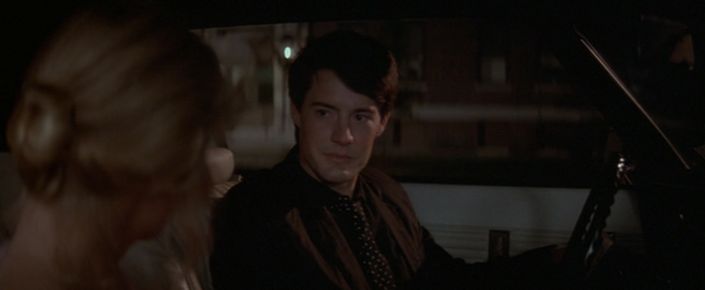 Back to selection
Back to selection
The Blue Velvet Project
Blue Velvet, 47 seconds at a time by Nicholas Rombes
The Blue Velvet Project, #40: A Plea For Less

Second #1880, 31:20
A PLEA FOR LESS
[This version of the Blue Velvet Project is published on the occasion of Blue Velvet‘s release on Blu-ray with deleted scenes on November 8th.]
There are probably many more good and sound reasons to make available Blue Velvet’s deleted scenes than not—I’ll concede that right from the beginning. For one thing, Lynch thankfully decided not to re-cut the film with the new scenes; this is not a “director’s cut.” Since Lynch was under contract to deliver a two-hour cut in 1986, it would make sense that the scenes (part of a longer, nearly four-hour version) would be restored to fulfill his artistic vision of the film. And yet he has chosen not to alter the Blue Velvet edit that he delivered to De Laurentiis, the version that most of us are familiar with. So in one sense, the deleted scenes are not much different than the sorts of extra-textual materials we encounter all the time, akin to the “restored text” version of, say, William Burroughs’s Naked Lunch. What’s not to celebrate, especially for the cinephile, about these deleted scenes?
Well, here are four laments, subjective and greedy and imperious as they may be, about the release of the deleted scenes:
1. Some movies become a part of who we are by dint of when we’ve seen them and how they accrue in our imaginations to the point where they are not just films that are “out there” but rather films that are “inside us.” To change (by the addition or subtraction of material) such films is to change history—not the history of the film, but our own personal, private histories. It’s as if the past itself becomes different. We all have stories about movies like this. Mine happens to be about Blue Velvet, mentioned in passing in a creative writing class by Dr. Raymont (a man clearly suffering his own private demons and practically disintegrating before our eyes) of the English Department at Bowling Green State University in 1987, and then me tracking it down at the local, family owned Kelly’s Video (which weirdly also sold men’s retro ties) and watching it on a television whose failing color tube stripped Blue Velvet of all its blue. The reader-response theorist Wolfgang Iser once suggested that “if a literary text does something to its readers, it also simultaneously reveals something about them. Thus literature turns into a divining rod, locating our dispositions, desires, inclinations, and eventually our overall makeup.” The same holds true for movies: what they teach us is not about them, but about us. We remember ourselves in the original experience of watching certain movies, especially at a formative age, before we have become cynical, when we still looked to films and books and music and art as something that could validate, challenge, and even somehow transform our fundamental views about the world and our precarious place in it. Who I am now is too enmeshed in what Blue Velvet was then. I don’t want it to change. I don’t want to remember it differently.
2. Throughout the history of art, constraint has served as a form of creative liberation. The fact that Lynch was required to deliver a two-hour cut of Blue Velvet forced the movie into leaner, narrower narrative pathways, ratcheting up the claustrophobic, terroristic atmosphere. More importantly, the narrative gaps in the film—chunks of time spent in the Williams’s home with Mike; the infamous “flaming nipple” scene—only make explicit what we already know: that the Williams’s are very nice, and that Frank is very bad. If the movie did not need these scenes to achieve its dark majesty in 1986, why does it need them now?
3. Does Blue Velvet require more meaning than it already has?
4. From Jacques Derrida to Mark Danielewski’s House of Leaves to David Foster Wallace’s Infinite Jest to the proliferation of extras/alternative endings/deleted scenes that are hallmarks of the digital postmodern, exploding the distinctions between so-called primary or master texts (i.e., the story itself) and supplementary texts (i.e., footnotes that are themselves part of the text) has become a commodity industry. Ours is an age of the remainder. The carried number. The internet is a detritus machine. In the mirror-hall logic of our time even capitalism eats itself. The relentless demystification of the past, which no doubt can be a form of liberation from the oppression of Myth, also serves to keep the past visible to such an extent that it becomes crippled and unable to fade into the crucial false remembering that is nostalgia. For nostalgia requires a radical separation from the past that allows for mis-remembering. As Fred Madison (Bill Pullman) says in Lost Highway: “I like to remember things my own way. . . . Not necessarily the way they happened.”
Over the period of one full year — three days per week — The Blue Velvet Project will seize a frame every 47 seconds of David Lynch’s classic to explore. These posts will run until second 7,200 in August 2012. For a complete archive of the project, click here. And here is the introduction to the project.
